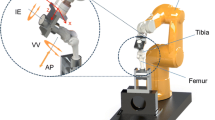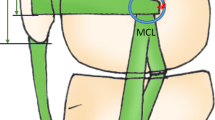Abstract
The meniscofemoral ligament (MFL) is a major structure in the posterior aspect of the porcine knee together with the posterior cruciate ligament (PCL). While the porcine knee is a frequently used animal model for biomechanical evaluation of PCL reconstruction techniques, the contribution of the MFL to stability of the porcine knee is not well understood. The purpose of this study is (1) to evaluate the kinematics of the knee after sequential cutting of the PCL and MFL and (2) to determine the in situ forces of the PCL and MFL in response to a posterior tibial load of 89 N using the robotic/universal force-moment sensor system from 15° to 90° of knee flexion. Ten porcine knees were used in this study. The magnitude of posterior tibial translation under a posterior tibial load was significantly increased (P < 0.01) after sequential transection of the PCL and the MFL at each testing angle compared to the intact condition. The in situ force of the PCL was highest at 60° of flexion (82.3 ± 8.6 N) and lowest at 15° of flexion (45.1 ± 15.9 N). The in situ force of the MFL was highest at 15° of flexion (24.3 ± 6.5 N) and lowest at 90° of flexion (12.9 ± 10.5 N). The findings in this study revealed a biomechanical contribution of the MFL as the secondary restraint to the posterior tibial translation in conjunction with the PCL especially near full extension.





Similar content being viewed by others
References
Amis AA, Gupte CM, Bull AM, Edwards A (2006) Anatomy of the posterior cruciate ligament and the meniscofemoral ligaments. Knee Surg Sports Traumatol Arthrosc 14:257–263
Chen CH, Chou SW, Chen WJ, Shih CH (2004) Fixation strength of three different graft types used in posterior cruciate ligament reconstruction. Knee Surg Sports Traumatol Arthrosc 12:371–375
Clancy WG Jr, Shelbourne KD, Zoellner GB, Keene JS, Reider B, Rosenberg TD (1983) Treatment of knee joint instability secondary to rupture of the posterior cruciate ligament. Report of a new procedure. J Bone Joint Surg Am 65:310–322
Coulier B (2009) Signification of the unusual delineation of the anterior meniscofemoral ligament of Humphrey during knee arthro-CT. Surg Radiol Anat 31:121–128
Fithian DC, Goltz DH, Funahashi TT (2003) Diagnosis of ligament injury Part C Instrumented laxity studies. In: Pedowitz RA, O’Corner JJ, Akeson WH (eds) Daniel’s knee injuries: ligament and cartilage structure, function, injury, and repair, 2nd edn. Lippincott Williams and Wilkins, Philadelphia, pp 370–408
Gupte CM, Bull AM, Murray R, Amis AA (2007) Comparative anatomy of the meniscofemoral ligament in humans and some domestic mammals. Anat Histol Embryol 36:47–52
Gupte CM, Bull AM, Thomas RD, Amis AA (2003) The meniscofemoral ligaments: secondary restraints to the posterior drawer. Analysis of anteroposterior and rotary laxity in the intact and posterior-cruciate-deficient knee. J Bone Joint Surg Br 85:765–773
Gupte CM, Bull AM, Thomas RD, Amis AA (2003) A review of the function and biomechanics of the meniscofemoral ligaments. Arthroscopy 19:161–171
Harner CD, Janaushek MA, Kanamori A, Yagi M, Vogrin TM, Woo SL (2000) Biomechanical analysis of a double-bundle posterior cruciate ligament reconstruction. Am J Sports Med 28:144–151
Kitamura N, Yasuda K, Tohyama H, Yamanaka M, Tanabe Y (2005) Primary stability of three posterior cruciate ligament reconstruction procedures: a biomechanical in vitro study. Arthroscopy 21:970–978
Lee BY, Jee WH, Kim JM, Kim BS, Choi KH (2000) Incidence and significance of demonstrating the meniscofemoral ligament on MRI. Br J Radiol 73:271–274
Lenschow S, Zantop T, Weimann A et al (2006) Joint kinematics and in situ forces after single bundle PCL reconstruction: a graft placed at the center of the femoral attachment does not restore normal posterior laxity. Arch Orthop Trauma Surg 126:253–259
Ma CB, Kanamori A, Vogrin TM, Woo SL, Harner CD (2003) Measurement of posterior tibial translation in the posterior cruciate ligament-reconstructed knee: significance of the shift in the reference position. Am J Sports Med 31:843–848
Margheritini F, Rihn JA, Mauro CS, Stabile KJ, Woo SL, Harner CD (2005) Biomechanics of initial tibial fixation in posterior cruciate ligament reconstruction. Arthroscopy 21:1164–1171
Park SE, Stamos BD, DeFrate LE, Gill TJ, Li G (2004) The effect of posterior knee capsulotomy on posterior tibial translation during posterior cruciate ligament tibial inlay reconstruction. Am J Sports Med 32:1514–1519
Rudy TW, Livesay GA, Woo SL, Fu FH (1996) A combined robotic/universal force sensor approach to determine in situ forces of knee ligaments. J Biomech 29:1357–1360
Stone JD, Carlin GJ, Ishibashi Y, Harner CD, Woo SL (1996) Assessment of posterior cruciate ligament graft performance using robotic technology. Am J Sports Med 24:824–828
Woo SL, Fisher MB (2009) Evaluation of knee stability with use of a robotic system. J Bone Joint Surg Am 91(Suppl 1):78–84
Zantop T, Lenschow S, Lemburg T, Weimann A, Petersen W (2004) Soft-tissue graft fixation in posterior cruciate ligament reconstruction: evaluation of the effect of tibial insertion site on joint kinematics and in situ forces using a robotic/UFS testing system. Arch Orthop Trauma Surg 124:614–620
Acknowledgments
The support of the Albert B. Ferguson, Jr. MD Orthopaedic Fund of the Pittsburgh Foundation is gratefully acknowledged.
Conflict of interest
Freddie H. Fu receives a research/educational grant from Smith & Nephew.
Author information
Authors and Affiliations
Corresponding author
Rights and permissions
About this article
Cite this article
Lertwanich, P., Martins, C.A.Q., Kato, Y. et al. Contribution of the meniscofemoral ligament as a restraint to the posterior tibial translation in a porcine knee. Knee Surg Sports Traumatol Arthrosc 18, 1277–1281 (2010). https://doi.org/10.1007/s00167-010-1134-0
Received:
Accepted:
Published:
Issue Date:
DOI: https://doi.org/10.1007/s00167-010-1134-0




